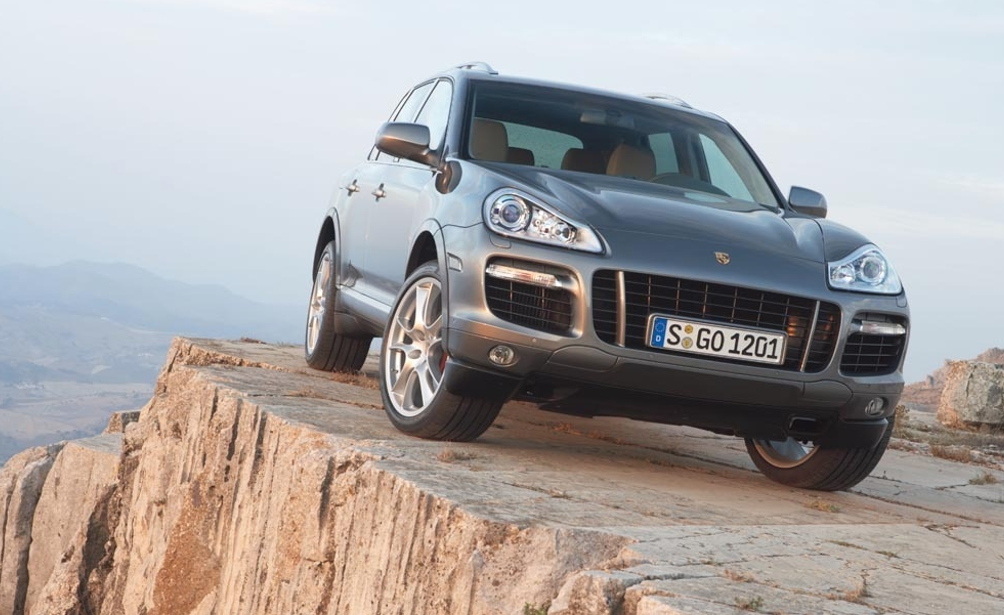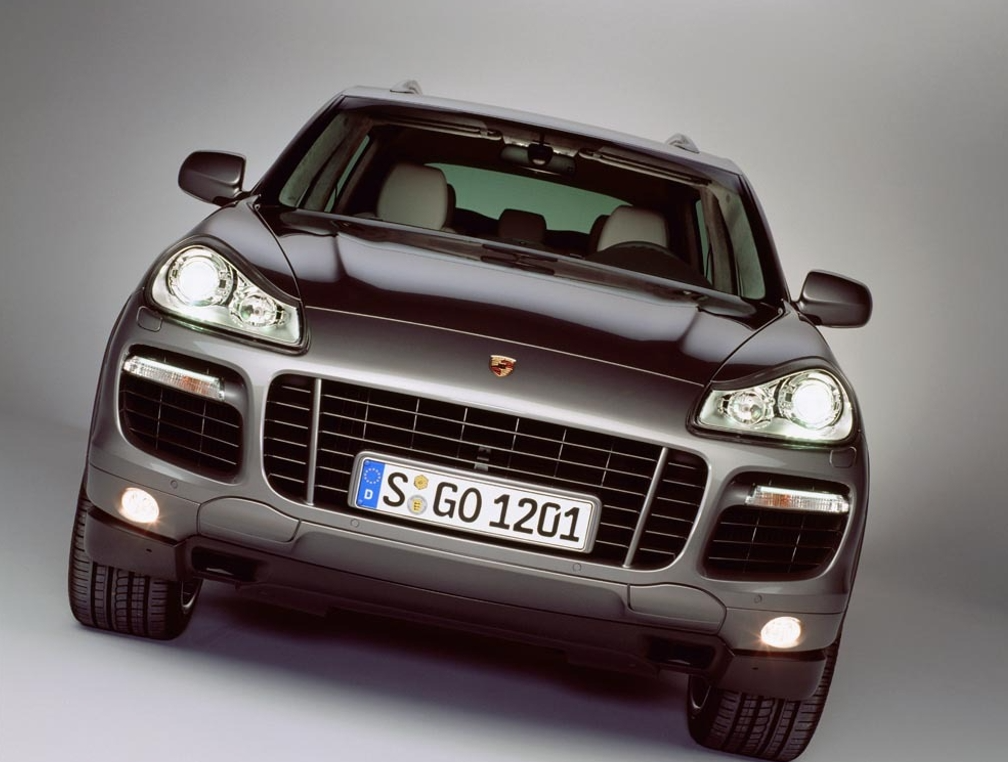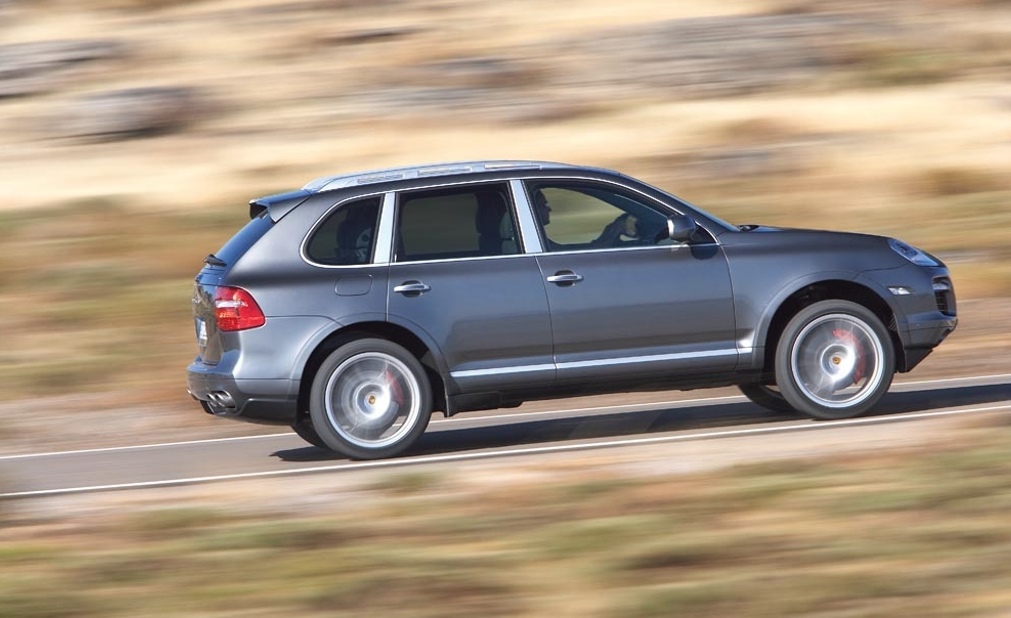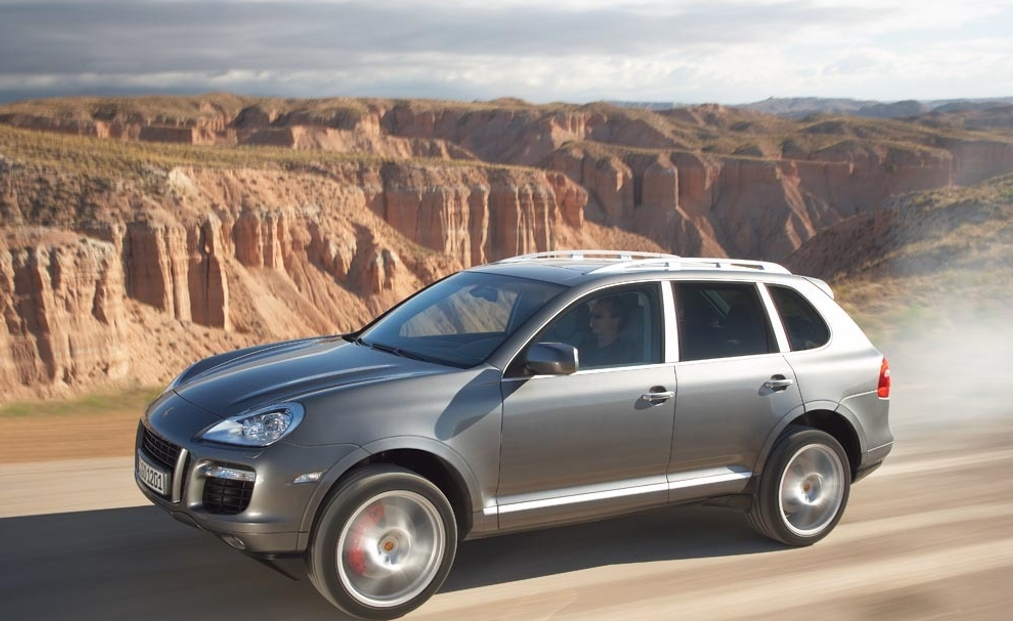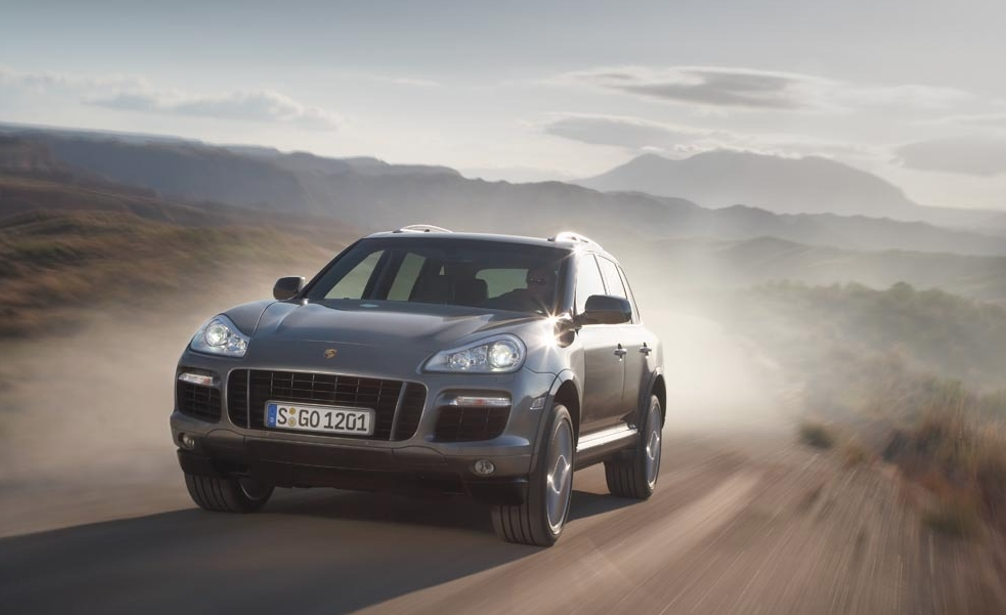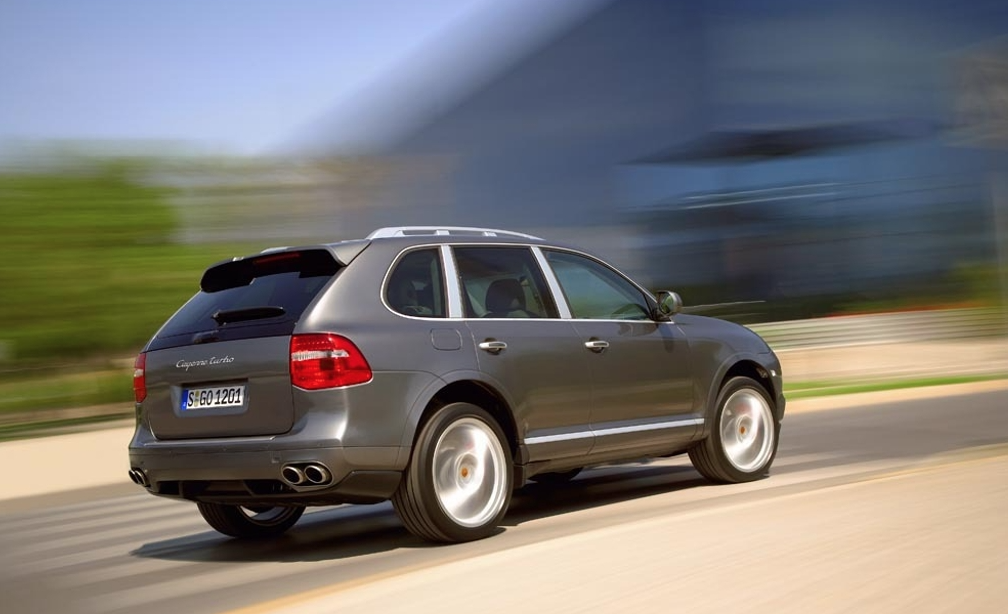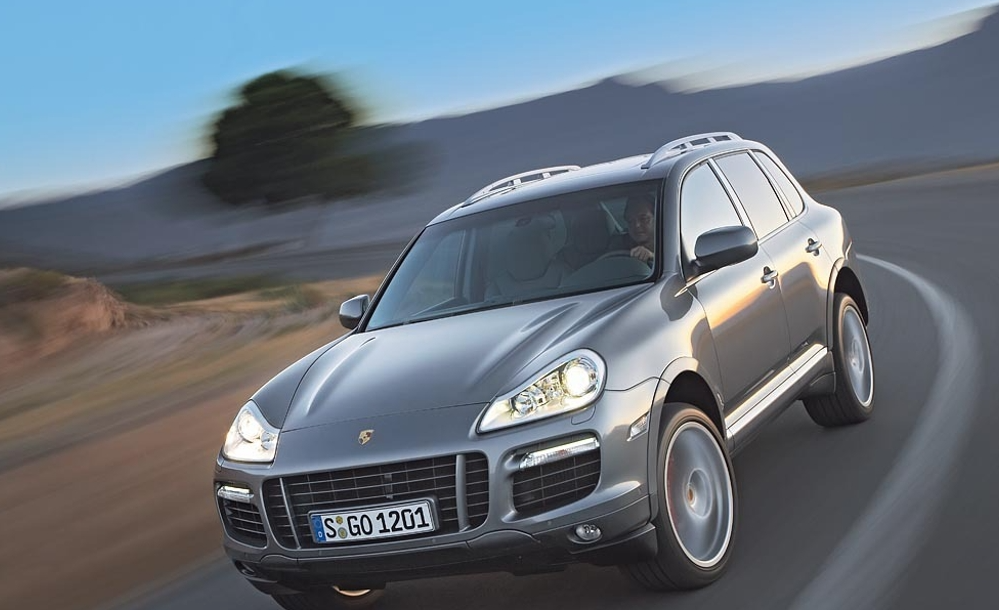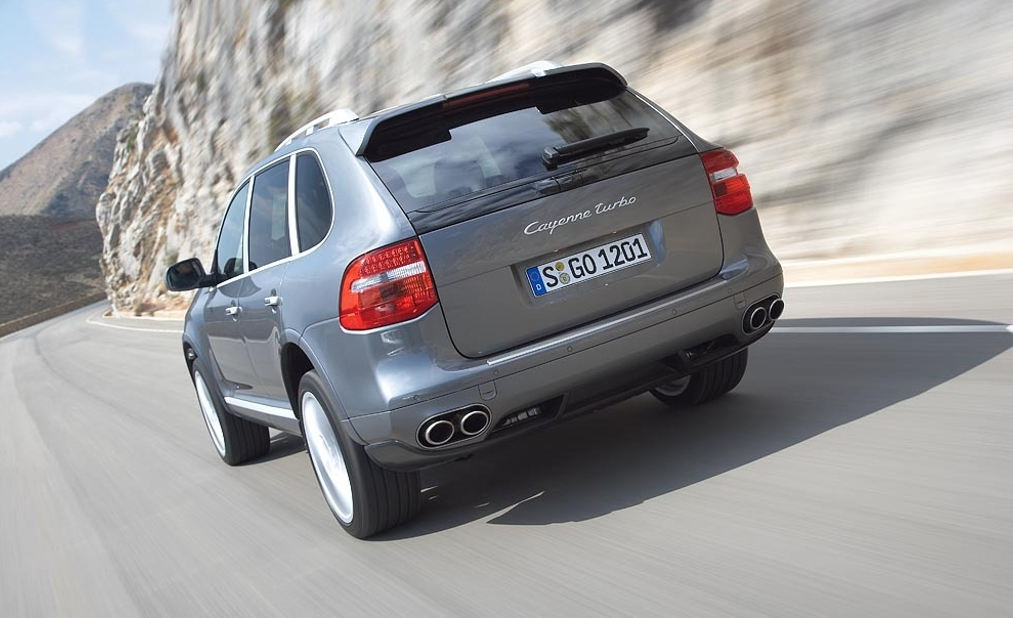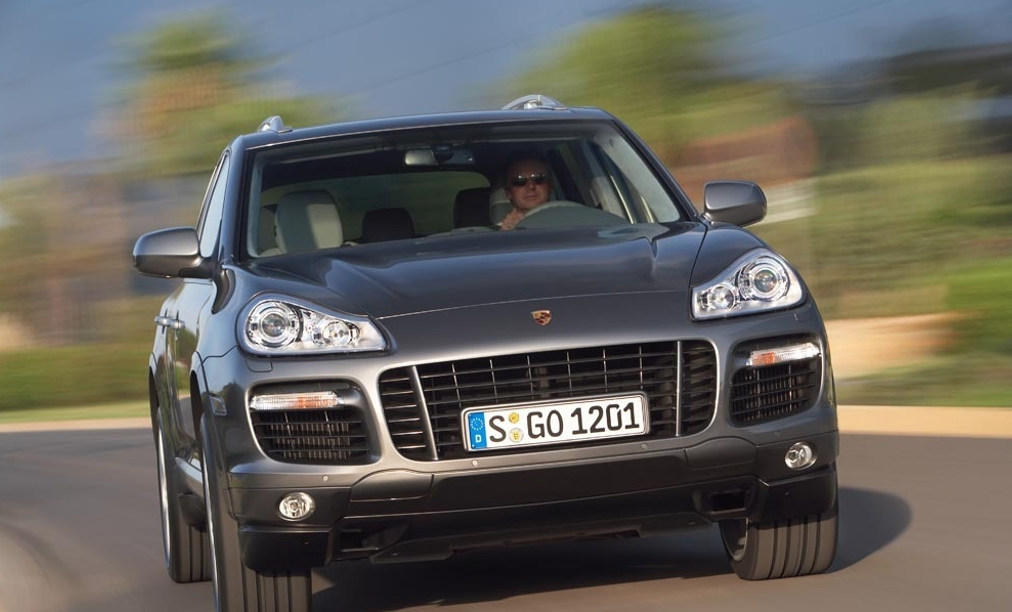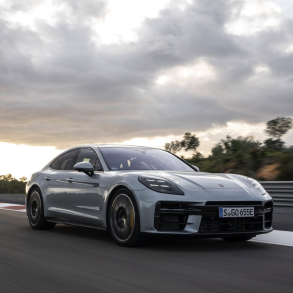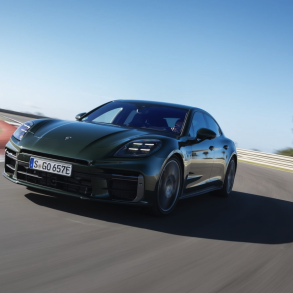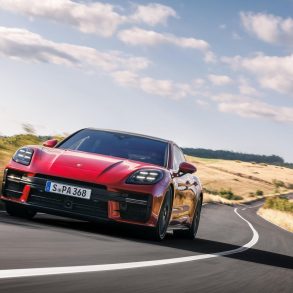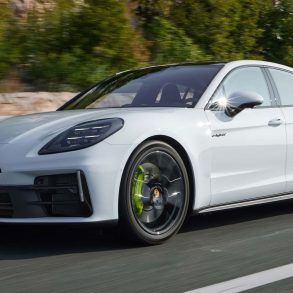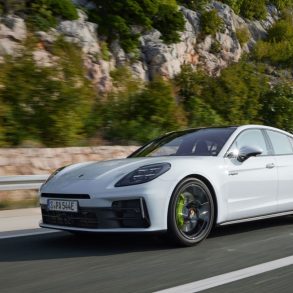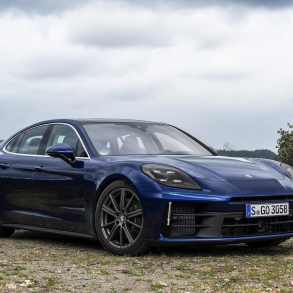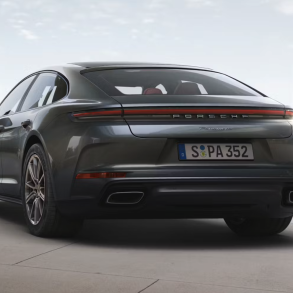(2008 – 2009) Porsche Cayenne Turbo – Ultimate Guide
The facelift for the first generation of the Cayenne was introduced in 2007 as a 2008 MY. More powerful in every respect – that is how the new generation of the Porsche Cayenne entered the market. New striking face upfront on a wide and muscular body, with headlights in brand-new design, and with broader, even more powerful-looking wheel arches. The Cayenne had already become a huge success with 160k+ units sold.
In 2007 an updated Turbo model 957, featuring a larger 4.8-L engine, was revealed at the Beijing Auto Show. It produces 50 PS (37 kW; 49 hp) more power, and can accelerate from 0–60 mph (97 km/h) in 4.9 seconds. Also revealed with the new Turbo, was a new 550 hp (410 kW) Turbo S model. Acceleration from 0–60 mph (97 km/h) for that car takes 4.7 seconds and it can be had with optional ceramic composite brakes.
For the 2007 facelift, the German car-manufacturer listened to its customers and got rid of the Porsche 996-inspired headlights. The new ones featured a clear lens over the lamps and they were re-shaped. A new, vertical, daytime running light appeared on the outer side of the side-scoops and the center grille was smaller. The Cayenne Turbo rode on 18” light-alloy wheels. It was fitted as standard with PASM (Porsche Active Suspension Management) and air suspension. The interior was almost unchanged when compared with its non-facelifted version. It featured the same seats and standard audio system. It received new colors for the leather seats. The Cayenne was fitted with a power-liftgate as an option.
The Cayenne Turbo was fitted with a direct-fuel injection system and VarioCam (variable valve timing). The bi-turbo engine offered a better fuel-efficiency than before also due to the longer transmission ratio, which allowed the engine to run at lower rpm than before. For the all-wheel-drive system, the Porsche Traction Management (PTM) was enhanced to offer better traction in all conditions.
Pictures
Press Release
More powerful in every respect – that is how the second generation of the Porsche Cayenne is entering the market: With a striking face upfront on a wide and muscular body, with headlights in brand-new design, and with broader, even more powerful-looking wheel arches, the optimised body makes a clear testimony to the Cayenne’s upgraded technical features.
All three model variants feature even more powerful engines beneath the engine compartment lid, and for the first time boast direct gasoline injection. Engine size has been increased, and the eight-cylinder models feature Porsche VarioCam Plus variable valve control as another first-time achievement. The result is an increase in engine power to 290 bhp (213 kW) on the six-cylinder and 385 bhp (283 kW) on the eight-cylinder. Maximum output of the Porsche Cayenne Turbo, in turn, is now exactly 500 bhp (368 kW).
Enhanced performance on less fuel
The introduction of Direct Fuel Injection and the significant improvement of aerodynamics with a drag coefficient of Cd = 0.35 on all three models benefits both performance and fuel economy, as well as other features, on all versions of the Cayenne. Top speed of the Cayenne is 227 km/h or 141 mph. The Cayenne S moves up this speed level quite significantly, reaching a top speed of 252 km/h or 156 mph. And at 275 km/h or 171 mph, the Porsche Cayenne Turbo is clearly the leader.
Despite this impressive performance, fuel consumption is down on the various models by more than 8 per cent in the New European Driving Cycle (NEDC), while under realistic driving conditions fuel economy is improved even more significantly by up to 15 per cent versus the former models.
PDCC: New, active anti-roll function
As an optional supplement to PASM Porsche Active Suspension Management, Porsche Dynamic Chassis Control (PDCC) is now available as a brand-new feature. Two active anti-roll bars set off body roll in bends almost 100 per cent, with the body showing a detectable reaction under such circumstances only when the driver prefers a very sporting style of motoring. In practice, this means that PDCC improves both driving safety, handling in general, and the high standard of comfort offered by the Cayenne models. And when driving off the beaten track, PDCC allows maximum interaction and adjustment of the axles in the interest of enhanced traction.
Upgraded PSM for even greater safety
Featured as standard, PSM Porsche Stability Management comes with various new functions: It now pre-loads the brake system whenever appropriate, offers a Brake Assistant, features enhanced Trailer Stability Control, and comes with offroad ABS. These additional functions ensure an even faster reaction of the vehicle when applying the brakes, prevent the Cayenne from developing potentially dangerous pendulum action when towing a trailer, and optimise the brake effect of Porsche’s Sports Utility on loose ground.
Fully controlled four-wheel drive for road and track
PTM Porsche Traction Management gives the Cayenne exceptionally superior driving characteristics on all kinds of roads and tracks. Via electronically controlled longitudinal locks, this permanent all-wheel-drive system is able to vary front-to-rear power distribution as required, depending on the respective situation. And featuring low-range transmission for offroad use, PTM also ensures absolutely excellent traction on heavy terrain.
Featuring Dynamic Curve Lights for the first time
The Porsche Cayenne Turbo comes as standard with new Dynamic Curve Lights supplementing the Static Curve Lights fitted so far. These Curve Lights are part of the bi-xenon headlight system designed and built for excellent illumination of the road ahead. The combination of Static and Dynamic Curve Lights offers outstanding advantages at both low and high speeds and is available as an option on the Cayenne and Cayenne S.
Rollover sensor for passive safety upgraded to a new standard
For the first time the new models in the Cayenne range come with a rollover sensor able in an emergency to trigger both the belt latch tensioners and curtain airbags, thus helping to reduce the risk of injury for all occupants in a rollover. Together with the six “regular” airbags, this gives Porsche’s Sports Utility an occupant safety and protection system once again setting the benchmark in the market.
New Generation, New Technology
The Porsche Cayenne is entering its second generation in fresh and powerful design, with new engines and an even higher standard of driving dynamics. The “basic” version of Porsche’s superior Sports Utility is now powered by a 290 bhp (213 kW) six-cylinder increased in size from 3.2 to 3.6 litres – offering an increase in maximum output over the former V6 by no less than 40 bhp or 29 kW.
Featuring a natural-aspiration V8 power unit up by 0.3 litres to 4.8 litres capacity, the Cayenne S now develops maximum output of 385 bhp (283 kW), 45 bhp (33 kW) more than before.
The increase in power on the eight-cylinder Cayenne Turbo with biturbo turbochargers is even more significant, the top model in the range now boasting exactly 50 bhp or 37 kW more in power than its predecessor, and thus raising the benchmark to precisely 500 bhp or 368 kW.
For the first time all three models come with direct gasoline injection giving the three versions of the Cayenne not only significantly more power, but also a substantial reduction of fuel consumption: The introduction of direct gasoline injection bearing the name Direct Fuel Injection or DFI in Porsche’s nomenclature serves to reduce fuel consumption of the individual models in the New European Driving Cycle (NEDC) by more than 8 per cent, with savings of up to 15 per cent under realistic driving conditions.
More muscle, less air drag
The new front end with modification of the swept angle configuration and new front wheel arches with even more striking contour lines at the top accentuate the muscular stature of the second-generation Cayenne. The low-slung headlights now moved far to the outside and covered by clear glass help to give the new model its unique face and character.
This new design comes together with a significant improvement of aerodynamics, with the Cayenne’s drag coefficient down from Cd = 0.38 (V6) and, respectively, Cd = 0.39 (eight-cylinder models) to the same low level of Cd = 0.35 on all three versions of the new model. This substantial improvement is attributable to a whole range of modifications including, inter alia, brand-new spoilers on the wheels, a front spoiler lip extending further down than before, newly designed exterior mirrors, and a roof spoiler with enhanced aerodynamics and air flow conditions.
The new Cayenne comes on 17-inch wheels, the Cayenne S and Cayenne Turbo are fitted as standard with newly designed 18-inch wheels. And all models are now also available with 19-inch all-season tyres, while brand-new wheels in attractive ten-spoke (Sports Wheel) or multi-spoke (Sports Plus Wheel) design measuring 21 inches in size provide an even more sporting look combined with enhanced performance on the road. Yet a further benefit of these new wheels is that they are no heavier than the 20-inch wheels also available as an option.
New power units: Fuel Consumption Down, Engine Power Up
As before, the Cayenne comes with a V6 power unit as the “basic” engine. The increase in engine capacity to 3.6 litres is accompanied by a reduction of the cylinder angle from 15o to 10.6o, while the introduction of Direct Fuel Injection operating at a pressure from 40 – 120 bar provides not only a significant increase in engine power, but also boosts engine torque from 310 – 385 Newton-metres (228 – 283 lb-ft) in the interest of significantly enhanced performance: The Cayenne accelerates to 100 km/h or 62 mph in 8.1 seconds and reaches a top speed of 227 km/h or 141 mph – as opposed to 9.1 seconds and a top speed of 214 km/h or 133 mph so far on the former model.
The eight-cylinder power units combine Porsche’s new DFI fuel supply system with the introduction of VarioCam Plus valve control. Featuring infinite valve timing and valve lift adjustment on the intake side, the 4.8-litre natural-aspiration power unit in the Cayenne S develops maximum torque of 500 Newton-metres/369 lb-ft (previously 420 Newton-metres/310 lb-ft) and accelerates the manual-gearbox model to 100 km/h two-tenths of a second faster than before in 6.6 seconds, with top speed now reaching 252 km/h or 156 mph (previously: 242 km/h or 150 mph).
Benefiting from two exhaust gas turbochargers, the eight-cylinder in the Porsche Cayenne Turbo now develops maximum output of 500 bhp together with peak torque of 700 Newton-metres or 516 lb-ft, accelerating the top model in the range to 100 km/h or 62 mph in just 5.1 seconds and providing a top speed of 275 km/h or 171 mph. This means an improvement in performance in the top model by half a second to 100 km/h, with top speed up by 9 km/h or 5 mph.
Despite this significant improvement of performance, fuel consumption in the New European Driving Cycle (NEDC) is down on all models: The manual-gearbox Cayenne consumes an average of 12.9 litres on 100 kilometres, equal to 21.9 mpg Imp or 0.3 litres less than its predecessor. And on the model with Tiptronic S automatic transmission, fuel consumption is down by an even more significant 0.6 litres.
The Cayenne S with manual gearbox now consumes 14.9 litres on average (19.0 mpg Imp), 0.9 litres less than the former eight-cylinder. And again, the Tiptronic S version is even more fuel-efficient, with average consumption of 13.7 litres/100 kilometres or 20.6 mpg Imp, an improvement by 1.2 litres over the former model.
Fitted with automatic transmission as standard, the Turbo comes with a reduction in fuel consumption form 15.7 to 14.9 litres/100 kilometres (18.0 to 19.0 mpg Imp), that is an improvement by 0.8 litres in overall terms.
The bottom line is that fuel economy in the NEDC is up by more than 8 per cent on some models. And under real-life driving conditions, that is driving in town, on country roads and on the German Autobahn, the new models even reduce fuel consumption by up to 15 per cent.
Reinforced transmissions
Both the Cayenne and the Cayenne S come as standard with a reinforced six-speed manual gearbox, while the Cayenne Turbo features Porsche’s six-speed Tiptronic S automatic transmission now developed to an even higher level of perfection and available as an option also in the Cayenne and Cayenne S.
Yet a further feature is that all models now have a longer final drive ratio.
The manual gearbox is combined as standard with the Porsche Drive-Off Assistant referred to as PDOA for short. This assistance system automatically intervenes in the brakes whenever required to prevent the vehicle from rolling back when the driver disengages the clutch. The automatic transmission also offers the same kind of roll-back prevention, where the Hill-Holder function when setting off in a forward gear on an uphill gradient prevents the Cayenne from rolling downhill.
Sports Button for extra dynamism
The new models in the Cayenne range give the driver the option, simply by pressing the new Sports Button featured as standard, to choose either the Standard or Sports suspension. In the Sports mode the engine responds even more spontaneously, and models featuring automatic transmission, air suspension and PASM Porsche Active Suspension Management come additionally with an even more sporting and dynamic configuration.
New option: PDCC for Anti-Roll Stability
Both the Cayenne and the Cayenne S come as standard with steel spring suspension, while the Cayenne Turbo features air suspension incorporating PASM Porsche Active Suspension Management. This very special suspension also available as an option on the Cayenne and Cayenne S offers not only adjustable damper control with three different settings, but also the option to lower or raise the entire body of the vehicle to various levels, with the Cayenne thus offering very substantial ground clearance of 271 millimetres or 10.67″ for tough off-road conditions.
PASM is now available for the first time together with PDDC Porsche Dynamic Chassis Control as a new option for enhanced Anti-Roll Stability. This infinite anti-roll control system limits body roll in bends and balances out the car’s angle under nearly all driving conditions, with the body showing only a slight movement in very dynamic and sporting situations.
As a result, the Cayenne offers not only a significant improvement in handling, but also an equally significant improvement of driving stability and motoring comfort.
PDCC is made up of two active anti-roll bars with hydraulic swivel motors integrated in the front and rear axles instead of conventional anti-roll bars. Responding very quickly and building up significant pressure of up to 180 bar, PDCC, through its active anti-roll bar configuration, is able to generate appropriate support and counter-forces before the body of the Cayenne is able to sway to the side in a fast bend.
PTM for excellent traction
Intelligent PTM Porsche Traction Management offers an ideal combination of very good onroad and offroad driving characteristics, distributing engine power in the standard mode at a 62:38 front-to-rear ratio. Depending on current requirements, a multiple-plate clutch operated by an electric motor and controlled electronically is able to vary the division of power as required, if necessary feeding up to 100 per cent of the engine’s power and torque either to the front or to the rear wheels.
PTM not only responds to a lack of traction, but also incorporates sensors measuring the speed of the vehicle, lateral acceleration, the steering angle, and the position and use of the gas pedal in order to provide enhanced control under the most extreme dynamic driving conditions. In difficult terrain, PTM is also able to use the offroad low-range gear integrated in the power divider with its transmission ratio of 2.7:1, also applying a 100 per cent longitudinal lock should any of the wheels lose ground contact.
PSM with an extended range of functions
Featured as standard in the Cayenne, PSM Porsche Stability Management communicates permanently and consistently with PTM Porsche Traction Management, but only intervenes when the Cayenne reaches the limits to driving physics. A sub-function of the anti-lock brake system, in turn, detects application of the brakes on loose ground, in response periodically increasing wheel slip during brake cycles. This offroad ABS function is therefore particularly advantageous on snow, sand or fine gravel, building up a wedge of the material beneath the vehicle in front of the wheels to provide an additional effect on loose ground or slippery surfaces.
The new Brake Assistant and the pre-loading function on the brakes significantly improves the overall quality and efficiency of the brake system: As soon as it detects application of the brakes in an emergency by means of information provided by the hydraulic PSM control unit, the Brake Assistant builds up the brake pressure required for maximum stopping power. The brake pre-loading function, in turn, develops higher pressure within the brake system immediately when the driver takes his foot abruptly off the gas pedal and therefore helps to shorten the stopping distance required under application of the brakes. Further improved Trailer Stability Control, finally, detects any pendulum motion on the trailer and intervenes by applying the brakes individually as required in the interest of enhanced brake stability.
Even higher standard of passive safety
Two full-size airbags for the driver and front passenger, two thorax side airbags, and two curtain airbags in the roof frame covering both the front and rear side windows ensure an exceptionally high standard of passive safety inside the Cayenne. With the exception of the centre seat at the rear, all seats come moreover with belt latch tensioners as well as belt force limiters on the front seats giving the occupants riding in the Cayenne optimum safety at all times.
Apart from collisions in a longitudinal and lateral direction, the sensors now for the first time also detect the risk of the vehicle rolling over. This function is provided by a new rolling rate sensor in the airbag control unit activating the belt latch tensioners and curtain airbags in an emergency.
Dynamic Curve Lights
Bi-xenon headlights featured as standard and supplemented by both Static and, for the first time, Dynamic Curve Lights enhance active safety to an even higher level in the Cayenne Turbo. The Dynamic Curve Lights are activated from a speed of just 3 km/h or 2 mph, ensuring better illumination of winding roads ahead. The Static Curve Lights, in turn, provide even better illumination of the road ahead close up to the vehicle.
This headlight system is also available as an option on the Cayenne and Cayenne S fitted as standard with H7 projection headlights.
New attractive features
Now entering its second generation, Porsche’s Sports Utility Vehicle comes with an even wider range of individual features and items of equipment. The automatic tailgate available as an option, for example, enables the driver to comfortably open and close the rear lid at the touch of a button. The new, optionally available loading area management comprising features such as a rail system integrated in the floor of the luggage compartment and a partition net allows even safer and more convenient stowage of luggage within the luggage compartment.
A new feature is the optionally available, highly attractive leather upholstery with natural leather in Black/Chestnut Brown.
For the first time the Cayenne is now also available with 21-inch wheels boasting ten-spoke design on the Cayenne Sports wheels and multi-spoke design on the SportPlus wheels. And to provide an even more sporting and dynamic character, the Cayenne S with Porsche’s Tiptronic S transmission is also available with a sports exhaust system featuring two double tailpipes.
Powerful Design, Exceptional Driving Dynamics
Boasting cutting-edge design, new power units with Direct Fuel Injection, more power and higher torque, as well as a new Driving Dynamics Package, the Porsche Cayenne is entering its second generation. And right from the start, the customer has the choice of no less than three model variants: the six-cylinder Cayenne, the Cayenne S with a V8 normal-aspiration power unit, and the Cayenne V8 Turbo.
Apart from the increase in engine size, one of the main features of these thoroughly updated and upgraded power units is Direct Fuel Injection combined in the eight-cylinder models with VarioCam Plus camshaft adjustment and valve lift control.
Together with the Cayenne’s significantly improved aerodynamics and the longer transmission ratios, this offers the customer a truly unique package of outstanding qualities providing not only a significant increase in power and performance, but also an equally substantial reduction of fuel consumption.
With their more comfortable set-up in standard configuration, the various types of suspension available underline the supremacy of the new Cayenne without requiring any concessions in terms of sportiness and performance. And with the new Sports Button featured as standard, the driver is able to enhance the sporting qualities of each model to an even higher level of perfection, the introduction of optional, active PDCC Porsche Dynamic Chassis Control providing a brand-new driving experience in the Cayenne in bends and on bumpy roads.
Porsche’s third model series was launched worldwide towards the end of 2002, following the 911 and the Boxster. By the end of 2006, approximately 150,000 units of the Cayenne have come off the production line at Porsche’s new plant in Leipzig. Hence, the Cayenne model series has significantly outperformed all expectations, proving that there is also room for a genuine Porsche in the sports utility segment.
New Face
Brand-new design at the front and rear-end design enhanced in an evolutionary process, even more striking lines and contours, as well as highly attractive interaction of convex and concave shapes emphasise the muscular stature of Porsche’s new Sports Utility Vehicle. Indeed, the new Cayenne has moved its optical centre of gravity as seen by the beholder even further to the back, offering a truly muscular and powerful look from every angle – sporting, dynamic, but nevertheless perfectly prepared even for the toughest terrain.
Extra-large air intakes demonstrate the superior power and performance of the new Cayenne models: On all three model variants, the front end is subdivided into three large air intake scoops with black grilles. On the Cayenne and Cayenne S, the front sections are characterised by two crossbars fitted horizontally into the outer air intakes and finished in body colour. The new Cayenne Turbo, in turn, boasts a much larger air intake in the middle, bearing clear testimony to the outstanding performance of this very special model and clearly positioning it as the top version within the range.
New lights design
Lower and wider than before, the headlights moved further to the outside of the front section and appropriately covered by clear glass lenses give the new Cayenne its unique “face”. Contour lines in the front wheel arches now moved further to the outside and with an even sharper profile, add to the Cayenne’s striking profile, creating an even more outstanding look. And thanks to the new wheel arches, the new Cayenne shows even more characteristic interplay of its flared wheel arch design, on the one hand, and the low, sleek engine compartment lid, on the other.
All models in the Cayenne range now come with foglamps positioned further down and further to the outside. While on the Cayenne and Cayenne S the direction indicators and parking lights are integrated vertically around the outer air intake scoops, they are positioned horizontally in the upper third of the air intakes on the Porsche Cayenne Turbo. The parking lights are formed by a LED lights bar, with the top-end model standing out from its two sister models also at night through its unique light design.
Specially contoured to form a complete front spoiler, the lower front lip extends down even deeper than on the former model, now surrounding the brake air intakes like a frame. The powerfully designed joint leading to the integrated front panel finished in body colour emphasises the robust SUV character of the Porsche Cayenne. And as an option the front panel is also available in stainless steel.
Available for the first time: 21-inch wheels
Wheels in unique design characterise all new models within the Cayenne range: The new Cayenne comes on 17-inch, the Cayenne S and Cayenne Turbo on 18-inch wheels as standard, all of them in new design. The 18-inch Cayenne S II wheels are an evolutionary development based on the former three-wing design, the 18-inch Cayenne Turbo II wheels in dual-spoke design, through their larger openings, help to ensure an even better flow of air cooling the brakes and provide a clear view of the brake system now enhanced for an even higher level of performance.
For the first time, the new Cayenne models are also available with 19-inch all-season tyres, while new 21-inch wheels offer an even more sporting and dynamic look through their multi-spoke design and enhanced performance of an even higher calibre. In consideration of their extra-large width, these wheels are combined in all cases with wider wheel arches finished in body colour and providing an even more sporting, wider look.
While the 21-inch wheels weigh more or less the same as the 20-inch wheels, they offer even greater stability in bends through their wide stance on the road and low side walls, adding the further advantage of even shorter stopping distances and even faster lateral acceleration.
Sporting and wide rear end
The fresh design of the new models continues in the rear lights now moved far to the outside, even firmer and more distinctive in their design. The reversing light is designed as a white light rod and is positioned right in the middle of the red light cluster.
The roof-line, in turn, is now extended by a redesigned roof spoiler creating a particularly sporting touch through its characteristic, inward-sweeping recess in the middle while at the same time providing a direct, unobstructed view of the third brake light.
A new, high-gloss black-painted band beneath the rear window gives the glazed area even larger visual dimensions, and another feature redesigned for even more attractive looks is the loading edge protection bar made of polished stainless steel. Apart from the attractive highlight added in this way, the particular feature is of course that the protection bar helps to avoid scratches on the body of the car when loading and unloading.
Two openings spaced out far apart at the rear for the tailpipes give the Cayenne an even more sporting look and enhance its wide, muscular appearance. The V6 and V8 models can be recognised at first sight through their oval tailpipe, while the V8 Turbo stands out clearly through its striking dual tailpipes.
Available as an option with either manual or automatic operation, the trailer towbar fits in elegantly behind an opening in the rear panel, without in any way impairing the silhouette of the bumper and no longer requiring an additional panel to cover the towbar.
Beneath the bumper, the rear diffuser stands out clearly at the end of the rear panel, again featuring an inward-sweeping recess in the middle like the roof spoiler.
More Power on Less Fuel
All power units featured in the new Cayenne boast Direct Fuel Injection for the first time. Benefiting from this technology as well as larger engine capacity, all three models offer significantly more power and torque on less fuel. In plain figures this means an average increase in engine output by 13 per cent and up to 15 per cent more fuel economy under realistic driving conditions.
The V6 power unit in the new Cayenne increased in engine size from 3.2 to 3.6 litres develops maximum output of 290 bhp (213 kW), 40 bhp (29 kW) more than on the former model. But at the same time fuel consumption in the Tiptronic S version is down from an average of 13.5 to 12.9 litres/100 kilometres (up from 20.9 to 21.9 mpg Imp) in the New European Driving Cycle (NEDC), just as the manual gearbox model is also more economical and fuel-efficient than before, with average consumption down from 13.2 to 12.9 litres/100 kilometres (up from 21.4 to 21.9 mpg Imp).
In addition to Direct Fuel Injection, the eight-cylinder models for the first time feature Porsche’s variable VarioCam Plus valve management further enhancing engine efficiency. As a result, maximum output of the eight-cylinder in the Cayenne S increased in size from 4.5 to 4.8 litres is 385 bhp or 283 kW. This represents an increase in engine power by 45 bhp or 33 kW coinciding with average fuel consumption of 13.7 litres/100 kilometres (14.9 litres with manual gearbox) (equal to 20.6 and, respectively, 19.0 mpg Imp) and therefore down considerably versus the former model: Compared with its V8 predecessor, the new Cayenne S with manual gearbox consumes 0.9 litres less fuel on 100 km, while the improvement on the Tiptronic S automatic transmission version is an even more significant 1.2 litres/100km.
Featuring two turbochargers, the Porsche Cayenne Turbo now develops 500 bhp (368 kW) maximum output from its 4.8-litre V8, 50 bhp or 37 kW more than before. But at an average of 14.9 litres/100 kilometres (equal to 19.0 mpg Imp), fuel consumption is down by 0.8 litres versus the former model.
Introducing these new power units with DFI Direct Fuel Injection, Porsche has succeeded in enhancing fuel economy in the New European Driving Cycle (NEDC) by more than 8 per cent on some models, with an even more significant improvement of fuel economy under real-life conditions by up to 15 per cent.
Direct Fuel Injection for greater efficiency
Direct injection of fuel into the combustion chambers is a very effective way to increase both engine output and efficiency. The fundamental benefit is that unlike conventional fuel injection through an intake manifold, the fuel/air mixture is formed in this case directly within the combustion chambers as such. So while, with indirect fuel injection, fuel is atomised upstream of the closed intake valve, Direct Fuel Injection injects the fuel directly into the cylinder after the valve has opened. Positioned between the two intake valves, the injector faces into the combustion chamber at an angle of 34o from the horizontal plane, injecting fuel directly into the two air flows in a conical configuration covering an overall angle of 70o. This eliminates the usual loss of fuel on the walls of the combustion chamber encountered in the conventional process whenever fuel mist comes to rest on the walls of the intake manifolds. Instead, it provides a better mixture of air and fuel in the cylinder, the fuel evapo
rating in the combustion process reducing temperatures in the combustion chamber, and the cylinders being able to draw in more air and benefit from a better cylinder charge. At the same time, the cooler fuel/air mixture serves to increase the compression ratio in the interest of even better efficiency and, as a result, more power on less fuel. This allows an increase in the compression ratio on the V6 power unit from 11.1:1 to 12.3:1, on the eight-cylinder from 11.5:1 to 12.5:1, and on the V8 biturbo from 9.5:1 to 10.5:1.
Variable pressure for optimum fuel injection
Direct Fuel Injection makes significant demands of the injection system. Under full load, for example, the engine is required to inject about 120 times more fuel than when idling – and it must do so within fractions of a second. Precisely this is why the injection period varies from 0.35 milliseconds shortly before switching off the overrun mode to just under 6 milliseconds under full load.
A further point is that fuel pressure is adjusted at all times to current requirements by a volume control valve on the high-pressure pump, thus varying within a range between 40 and 120 bar, depending on engine load. This is done on the six-cylinder by a single piston pump, while the Cayenne S features an axial piston pump with three pistons. The Cayenne Turbo, in turn, uses an axial piston pump upgraded to an even higher standard through the incorporation of six pistons.
In each case the pump is driven by the intake camshaft on the right-hand row of cylinders, supplying the fuel injectors with fuel through a common high-pressure rail.
More economical right from the start
Right from the start the new power units in the Cayenne differ in their start-up and running characteristics from engines with conventional intake manifold injection: A process referred to as the high-pressure stratified engine start-up ensures minimum fuel consumption and low emissions from the beginning during initial operation of the engine. While intake manifold injection tends to deposit fuel on the walls of the cylinders and the valves during the intake process, such fuel therefore being wasted and no longer available for the actual combustion process, Direct Fuel Injection does not start when the engine is fired until shortly before the end of the compression stroke.
A special feature of the high-pressure stratified start-up concept is that fuel is injected precisely into the purpose-designed piston recess forming a stratified build-up of fuel to provide an ignitable mixture around the spark plug. The piston recess ensures that the fuel injected is guided directly to the spark plug, reducing not only the amount of fuel required versus intake manifold injection, but also the volume of emissions.
Double injection for clean emissions at an earlier point
After starting up in the high-pressure stratified charge mode, engine management switches over to the catalyst heat-up phase, with dual injection increasing emission temperature and thus heating up the catalytic converter as quickly as possible. Then, like in the high-pressure start-up mode, fuel is injected a second time into the piston recess, shortly before the end of the compression stroke. With the fuel/air mixture being ignited at a very late point, exhaust gas temperature is further increased, again serving to reduce emissions during the start-up phase. And last but not least, none of the engines now requires a secondary air pump, which used to be essential.
Dual injection is then used a second time in the higher load range at engine speeds of up to approximately 3500 rpm – for example when the driver presses down the accelerator at low engine speeds while accelerating in gears. In this case the amount of fuel required for combustion is split up into two successive injection processes both conducted during the intake stroke with open intake valves to provide enhanced fuel/air mixture formation and, as a result, yet a further improvement in fuel economy.
In all other operating modes, fuel is injected in one single process, offering the driver yet a further advantage provided by the new process of fuel/air mixture formation: With fuel being injected directly prior to the energy stroke, the engines respond even more smoothly and spontaneously to every movement of the gas pedal. This is not only the case when accelerating, but also when the driver takes his foot off the gas pedal, since there is no residual gas left in the intake manifold which still has to be burnt.
3.6-Litre V6 Power Unit
The V6 power unit remains the “basic” engine in the Cayenne. But now an increase in engine capacity by 0.4 to 3.6 litres and the introduction of Direct Fuel Injection offers not only significantly more power, but also an increase in torque by 75 Newton-metres or 55 lb-ft to 385 Newton-metres or 284 lb-ft.
This means significantly better performance on the road, with the new Cayenne accele-rating to 100 km/h in just 8.1 seconds, a complete second faster than its predecessor. And benefiting from the vehicle’s optimised streamlining, top speed is up from 214 to 227 km/h (133 to 141 mph).
Smaller cylinder angle for extra lift
Only a few of the engine’s parts and components remain unchanged. Over and above the introduction of Direct Fuel Injection and the increase in engine capacity, for example, the cylinder angle has also been modified and is now 15o, as opposed to 10.6o in the past. This significant change was indeed necessary due to the increase in cylinder bore by 5 millimetres to 89 millimetres or 3.50″.
To make the engine a really strong and stiff structure, the distances between the cylinders had to be increased at the bottom, while the gaps between the cylinder bores at the top, that is the partition leading to the cylinder head, remain the same as before.
Cylinder stroke has also been increased by 0.5 millimetres or almost 0.2″ to 96.4 millimetres or 3.80″, giving the engine overall capacity of 3598 cc. The cylinder head in the Cayenne is made of one single piece of aluminium thoroughly redesigned for the Direct Fuel Injection power unit. Apart from integration of the fuel injectors, the coolant and oil cavities have also been adapted to the new engine, and to allow a higher level of gas throughput, valve stroke is up by 1 millimetre to 11 millimetres or 0.43″. At the same time, the diameter of the cylinder charge ducts has been increased and the cylinder charge improved in the process.
Variable valve timing and switching intake manifold
The two overhead camshafts in the cylinder head are masterminded on the intake and exhaust sides by a vane-cell adjuster. The valves themselves are operated by roller-type drag arms with friction reduced to a minimum in the interest of enhanced fuel economy.
With its long-stroke cylinder geometry, the V6 power unit ensures superior torque at low engine speeds, a two-mass damper at the free end of the crankshaft serving to reduce rotational vibrations on the crankshaft and loads generated in the process.
The six-cylinder power unit draws in air through a switching intake manifold made of a special synthetic material. Extension of the intake manifold at low engine speeds serves to maximise the level of torque, while at 4250 rpm the intake manifold switches over to the short air duct in the interest of extra power and torque.
Two advance and two main catalysts each in the exhaust system of the new Cayenne serve to convert carbon monoxide, hydrocarbons and nitric oxide in a highly efficient process. The entire exhaust system now extends all the way back to the rear mufflers in two chambers, thus reducing flow resistance to a minimum. The two main catalysts lead directly into a pre-muffler connecting the two exhaust pipes on either side and thus improving both the charge cycle and the torque curve at low engine speeds.
4.8-Litre V8 Naturally-Aspirated Power Unit
Powerful torque from low engine speeds and agile performance for sports motoring – this appropriately describes the character of the eight-cylinder in the Cayenne S.
The new power unit achieves the “magic” torque level of 500 Newton-metres or 369 lb-ft at just 3500 rpm, reaching its maximum output of 385 bhp or 283 kW at 6200 rpm – an increase versus the previous model by 80 Nm (59 lb-ft) and, respectively, 45 bhp.
On the road this means a significant improvement in performance, with the V8 accelerating the manual-gearbox Cayenne S to 100 km/h two-tenths of a second faster than before in just 6.6 seconds, and with an even more significant improvement in the Tiptronic S model by four-tenths to 6.8 seconds. Top speed is up from 242 to 250 km/h (150 to 155 mph) in the automatic transmission version and has been improved even further to 252 km/h (156 mph) in the manual-gearbox model.
This significant increase in performance required more than “just” an increase in engine size to 4.8 litres provided by the cylinder bore now up 3 millimetres. Indeed, only the interaction of Direct Fuel Injection with VarioCamPlus valve management originally developed by Porsche for sports car engines was able to make this improvement possible. And a further point is that this increase in power and torque coincides with a reduction in fuel consumption by approximately 15 per cent.
Proven basic design
Only the proven closed-deck construction of the crankcase made of light alloy has been carried over from the former 4.5-litre power unit. Using this configuration, the housing and the cooling ducts around the cylinders form a complete, self-contained system with a closed bedplate leading to the cylinder head to make the cylinder block very stiff and sturdy, in particular enhancing the stiffness of the cylinders themselves.
To develop the high torque of the eight-cylinder smoothly and safely while maintaining the superior stiffness of the basic engine block, the crankshaft bearings rest in a so-called bedplate, that is a stable frame integrating the five lower main bearing sections on the crankshaft for the first time in one single component made completely of aluminium. This new aluminium bedplate thus replaces the former unit with its cast inserts.
Single-piece aluminium cylinder head
The V8 power unit has lost weight not only lower down at the bottom, but also right at the top on head level, where the former two-piece cylinder head made up of the head itself and the camshaft box is now replaced by a single-piece construction made of die-cast aluminium.
Apart from the new openings for the injection jets, valve drive has been converted to even more efficient control by VarioCamPlus, infinite adjustment of valve timing also serving to vary intake valve lift all the way from 10 to 3.6 millimetres. This valve lift control system is made up of two interacting, switching cup tappets on the intake side of the engine operated by two cams of varying size on the camshaft.
This superior configuration gives VarioCamPlus an even wider range of options and freedom in adjusting the gas charge cycle: While engine stroke is kept to a small level when idling and under part load, the system switches to larger stroke at speeds of approximately 4000 rpm and above, thus improving fuel economy and emission management without making any compromises in terms of torque and output.
Optimised flow conditions in the coolant ducts serve furthermore to improve the thermal balance in the cylinder head, reducing the thermal load to such an extent that the new cylinder head may be used in both the normal-aspiration and turbocharged power unit.
The eight-cylinder normal-aspiration engine owes its “bullish” character also to the switchable intake system: Switching over to a long intake manifold setting whenever appropriate, the new power unit develops significantly more torque right from the start below engine speeds of approximately 4200 rpm than the former 4.5-litre. Subsequently shortening the intake manifold setting, the engine then offers higher specific output, power and performance at high engine speeds. And despite this new construction with additional, integrated switching flaps, overall weight of the intake system is down by 0.3 kg, with a saving of approximately 1.1 kg on the V8 Turbo engine.
New on-demand oil pump
To ensure a smooth and reliable supply of oil in all situations, the V8 power unit now comes with integrated dry sump lubrication. The oil sump itself is now split horizontally and a new feature is the variable oil pump used for the first time in the Cayenne: Adjusting the width of the gears hydraulically as a function of oil pressure, the variable oil pump is able to regulate its delivery volume individually according to the driver’s current requirements. This reduces the consumption of energy by the oil pump to a minimum, while maintaining adequate lubrication at all times in accordance with current engine loads and running conditions.
The exhaust system in the Cayenne S is designed to warm up the catalytic converters as quickly as possible to their standard operating temperature. This is done by keeping the exhaust gas manifolds very short and using the high temperature of the exhaust gas to heat up the catalysts. A further advantage of the modified pipes is a significant increase in torque.
Sports exhaust system providing a particular sound
In conjunction with Tiptronic S, the new Cayenne S comes for the first time with a sports exhaust system featuring a modified main silencer to provide an even more voluminous sound typical of a V8. The system is set to the special sound mode by a new Sports Button, generating its unique sound as a function of engine load, road speed, engine speed, and the gear currently in mesh.
The sports exhaust system is clearly recognisable through its striking dual tailpipes finished in chrome-plated stainless steel reminiscent in design of the dual tailpipes featured as standard on the new Cayenne Turbo. A bar connecting the pipes nevertheless provides a unique, different look reserved exclusively to the Cayenne S with its sports exhaust.
4.8-Litre V8 Turbo Engine
The new Porsche Cayenne Turbo naturally remains right at the top in the high-performance SUV market: Biturbo technology, Direct Fuel Injection and VarioCam Plus valve management give the new 4.8-litre maximum torque of no less than 700 Newton-metres or 516 lb-ft maintained all the way from 2250 – 4500 rpm. Just one look at other vehicles in the market confirms that this is more than even significantly larger gasoline engines have to offer.
The result of this supreme torque is acceleration to 100 km/h in the top-of-the-range Cayenne in just 5.1 seconds. And maximum output of 500 bhp (368 kW), in conjunction with exemplary streamlining (Cd = 0.35), gives this high-performance Sports Utility a top speed of 275 km/h or 171 mph – again an absolutely unique achievement in this segement.
The Porsche Cayenne Turbo features new turbochargers with a larger radial turbine. The two exhaust gas turbochargers are arranged in parallel as before, with one turbine for each row of cylinders. To give the turbochargers an even faster and more dynamic response, the intake manifolds are shorter than before and, unlike the manifolds on the power unit of the Cayenne S, do not require switchable flaps.
The two turbochargers deliver their maximum pressure of approximately 1.8 bar as of an engine speed of 2250 rpm, where the engine also develops its highest level of torque. To maintain torque at this supreme level as long as possible, turbocharger pressure is reduced as a function of increasing engine speed.
A further feature of the water-cooled exhaust gas turbochargers integrated in the engine’s oil circuit is the built-in oil extractor guiding the lubricant into the engine’s oil sump.
Crankcase with fresh air rinsing effect
The basic engine block on the Cayenne Turbo is largely comparable to the naturally-aspirated eight-cylinder block. The differences lie in important details such as the use of forged instead of cast light-alloy pistons. A fine but important difference is also to be seen in the special purge system on the crankcase made necessary by the combination of turbocharging and Direct Fuel Injection, where the turbocharged power unit uses the fresh air rinsing effect throughout the entire crankcase. As a result, air is extracted via the cylinder head cover and is fed to the low-pressure section of the intake manifold when running under part load.
Six Gears with even Harder Teeth
The Cayenne and Cayenne S both come as standard with a six-speed manual gearbox adjusted to the new level of power and performance. In both cases the gear teeth are made of an even stronger material, with the bearings also optimised on the Cayenne S manual gearbox.
The spring rate on the two-mass flywheel and the spring forces in the clutch are also geared to the particular characteristics and features of the new engines, the increase in engine power and the improved drag coefficient allowing the use of a longer final drive ratio without making any concessions in terms of agility and driving dynamics.
This no only serves to reduce fuel consumption, but in particular increases motoring comfort on long distances thanks to lower engine speeds: In sixth gear, for example, the power unit in the Cayenne V6 runs at just 3000 rpm at a speed of 130 km/h or 81 mph, while the engine in the former model revved at 3300 rpm in the same speed range.
Drive Off Assistant when setting off on an uphill gradient
The manual gearbox is now combined as standard with the Porsche Drive Off Assistant or PDOA for short. This assistance system offers the driver significantly improved conditions when setting off on an uphill gradient, automatically intervening in the brakes to prevent the vehicle from rolling back. So once the driver engages the clutch, the system takes back brake pressure and the Cayenne is able to set off smoothly and dynamically without slipping back.
PDOA intervenes whenever the vehicle is at a standstill with its engine running, with a forward gear in mesh and the driver pressing the clutch and brake pedals at the same time. Then, once he takes his foot off the brake pedal or lets go of the handbrake, PDOA will maintain the level of brake pressure required until a gear is engaged.
Should the driver interrupt the process of setting off, in turn, brake power is immediately built up again.
PDOA is not intended as a substitute for the regular parking brake and is therefore deactivated whenever the engine is switched off.
Reinforced automatic transmission
The Cayenne Turbo comes as standard with Porsche’s six-speed Tiptronic S also available as an option on the Cayenne and Cayenne S. The characteristics of both the torque converter and the converter lock-up clutch have been adapted to the new generation of power units, the lock-up clutch on the eight-cylinder models now featuring two friction discs for conveying even more power and torque.
To cater for the increase in power on the Porsche Cayenne Turbo, both gearshift pressure and the number of clutch plates have been increased accordingly, serving to improve the transmission of forces, speeding up the change in gears, and making the entire gearshift process even more comfortable. Yet a further improvement is the reinforcement of the bearings in the planetary gearset.
In the new generation of the Porsche Cayenne featuring automatic transmission, the transmission fluid flows through radiators with reduced flow resistance, enabling the automatic transmission to provide a Hill-Holder function automatically preventing the vehicle from rolling back when setting off on an uphill gradient.
Like their counterparts with a manual gearbox, the Tiptronic S models feature longer final drive ratios for lower engine speeds and, in particular, a further reduction of fuel consumption.
Shifting to neutral at a standstill for enhanced fuel economy
To save fuel, the Cayenne with Tiptronic S now comes with automatic gear disengagement, meaning that Tiptronic S automatically shifts to neutral as soon as the driver presses down the brake pedal with the vehicle at a standstill and on a flat surface. This is done by opening the transmission entry clutch, with an appropriate reduction of converter losses due to the low level of torque transferred under these conditions from the engine to the torque converter.
Sports Button for even better performance
Even more than before, the new Cayennes give the driver an even wider range of choice in determining the specific character and features of the vehicle. This he can do by means of the Sports Button positioned in the lower section of the centre console, allowing the driver to choose between the economic Standard mode and the particularly dynamic Sports mode.
In the Standard or Normal mode engine management is programmed for optimum fuel economy, while in the Sports mode specially highlighted in the instrument cluster the engine responds even more spontaneously and dynamically thanks to its steeper gas pedal control line providing an even more direct and “harder” response to the driver’s commands.
In the Sports mode the Cayenne always sets off in first gear and the gearshift points are even more dynamic and sporting, with the transmission shifting up later and shifting gears at an earlier point. And after application of the brakes, the driver will always benefit from exactly the right gear when accelerating again.
As before, the shift pattern is adapted to the driver’s style of motoring at all times within the two Sports and Standard modes. To obtain the most sporting and dynamic set-up from the start by activating the Sports Button, the gearshift control line in Tiptronic S switches directly to the very dynamic Sports mode map.
The sports exhaust system also available in conjunction with Tiptronic S on the Cayenne S is likewise activated by the Sports Button.
Sports Button also controlling PASM and PDCC
Models with air suspension and Porsche Active Suspension Management (PASM) automatically switch over in the Sports mode to the Sports program featured in Porsche’s variable PASM damper system, air suspension lowering the entire vehicle to its lowest point.
Porsche Dynamic Chassis Control (PDCC), the new active chassis control system available as an option, also switches to the Sports mode in this case, with the Sports mode remaining active until the driver either presses the button again or switches off the ignition.
Enhanced Comfort and even Greater Driving Dynamics
Right from the start, the Cayenne has always given customers the option to choose their very own chassis and suspension tailored to their personal requirements.
The steel spring suspension serves from the outset to provide optimum conditions for all-round use of the vehicle, while air suspension based on this technology and PASM Porsche Active Suspension Management allows the driver and passengers to choose their own particular standard of comfort and sporting performance tailored most individually to their personal wishes.
Now, moving on to the next generation of the Cayenne, Porsche is enhancing these options through the addition of yet another system: Porsche Dynamic Chassis Control (PDCC), a system featuring active anti-roll management and combined with both air suspension and PASM.
Secure and proven foundation
As before, both the Cayenne and Cayenne S come with a steel spring chassis. A brand-new feature, on the other hand, is the configuration and set-up of the springs, dampers and anti-roll bars: While all of these components retain their sporting features, Porsche’s engineers have now focused in particular on the improvement of long-distance comfort. The front axle developed for the Cayenne is a double-wishbone axle resting on widely positioned mounts placed far apart on the subframe. In conjunction with the small adverse forces lever arm, the large distance between the wishbones or track control arms keeps forces in the suspension to a minimum. The result is precise wheel guidance at all times for superior agility and efficient minimisation of adverse forces. And thanks to the use of extra-large rubber mounts, the elastic bearings on the subframe serve to reduce road noise in the interest of extra comfort.
Both the steering transmission and the differential are housed in a protective area on the subframe, offering particular benefits above all when driving on a rough track. Like all Porsche models, the Cayenne furthermore comes as standard with rack-and-pinion steering featu-ring hydraulic power assistance. This variable assistance and the specific configuration of the valve control line ensure an even higher standard of driving agility.
At 16.7:1, the steering transmission ratio in straight-ahead position is comparable to that in a sports car, then becoming even more direct as a function of greater steering lock. In practice, this means just 2.65 rotations of the steering wheel from lock to lock – a great advantage when parking and manoeuvring.
The rear axle is a special development for the Cayenne range, the sophisticated multi-arm concept being perfectly matched to both the traction forces and heavy loads possibly acting on the Cayenne and therefore meeting the substantial demands made of a thoroughbred sports utility. New spring strut support mounts made of special elastic foam replace the conventional steel/rubber mounts, not only saving 45 per cent weight in the process, but also adding further benefits such as better damping characteristics and lower roll noise.
The four hydraulic mounts on the subframe have been replaced by a new, upgraded construction offering even greater vertical stiffness and optimised damping in longitudinal direction in the interest of enhanced driving comfort.
The lower track control arm and tiebar are made of steel in order to cope with the higher loads and forces typically experienced on a rough track. The upper track control arm, on the other hand, benefiting from its protected position, is made of lightweight cast aluminium.
A particular feature of the axle concept is the long spring travel for superior driving characteristics off the beaten track: On the standard steel spring suspension featured in the Cayenne and Cayenne S, inbound and rebound spring travel on the front axle is 104 and, respectively, 116 millimetres (4.09 and, respectively, 4.57″), while the corresponding figures at the rear are 135 and 98 millimetres (5.31 and 3.86″).
Air suspension with PASM for enhanced flexibility
The new Cayenne Turbo comes as standard with air suspension including PASM Porsche Active Suspension Management, and the same suspension is also available as an option on the Cayenne and Cayenne S.
Air suspension increases inbound and rebound spring travel on the front axle to 102 and, respectively, 118 millimetres (4.02 and, respectively, 4.65″), and to 124/125 millimetres (4.88/4.92″) at the rear. Featuring integrated self-levelling, the air suspension serves furthermore to maintain a consistent ride height regardless of the load the vehicle is currently carrying. Yet a further feature is automatic reduction of ride height as a function of speed, enhancing active safety and reducing fuel consumption in the process.
Adjustable to six different levels, air suspension provides an overall adjustment range of 110 millimetres or 4.33″:
In the normal mode, ground clearance is 215 millimetres or 8.46″ beneath the axles.
In the fully laden mode, that is the lowest possible position, the Cayenne Turbo moves down 52 millimetres or 2.05″ on the front axle and 55 millimetres/2.17″ at the rear beneath its standard ride height. This setting is only possible with the vehicle at a standstill in the interest of highly convenient and comfortable loading and unloading. Then, when setting off, the system automatically raises the vehicle to its normal level.
At the low level, the Cayenne Turbo is 22 millimetres or 0.87″ beneath its standard level, and is therefore comparable to a vehicle with sports suspension. This means that the suspension is firmer and air resistance lower, making the Cayenne Turbo even more stable and dynamic at high speeds. And then, as of a road speed of 125 km/h or 78 mph, the body automatically moves down to its low level.
The Cayenne Turbo automatically switches over to its special low level as of a speed of 210 km/h or 130 mph, thus moving down another 10 millimetres or almost 0.4″ versus the low level.
The offroad level with enhanced ground clearance is intended for rough terrain and difficult tracks. In this case the entire vehicle is raised 28 millimetres or just over 11.0″ above its standard level only possible at speeds of up to 80 km/h or 50 mph.
The special offroad level is intended for the most extreme offroad conditions, raising the Porsche Cayenne Turbo another 30 millimetres or 1.18″ to ground clearance of no less than 271 millimetres or 10.67″. This setting is limited to speeds of up to 30 km/h or 20 mph.
PASM with an enhanced range of operation
Air suspension is combined with PASM Porsche Active Suspension Management allowing infinite, ongoing adjustment of damper forces as a function of surface conditions and the driver’s style of motoring.
A big advantage of PASM is that it enables the driver to choose his personal damper set-up while driving, offering the Comfort, Normal and Sports programs with even more distinctive features and characteristics in the new model and therefore covering an even wider range of settings to the benefit of the driver and passengers.
As an example, PASM intervenes appropriately whenever the driver opts for a very dynamic style of motoring with fast and powerful acceleration and deceleration or on particularly bumpy terrain, appropriately counteracting any roll and pitch motion of the vehicle. No less than five accelerometers monitor body and wheel movements in the process, the system stabilising the vehicle as soon as such movements exceed a certain limit, depending on driving conditions.
Always remaining active in the background, PASM monitors the driver’s style of motoring by means of the program currently selected. So should the driver choose a comfortable damper setting while driving in a very dynamic and sporting style, the system will automatically switch to a firmer and harder damper mode.
PDCC for a brand-new feeling in bends
Introducing PDCC Porsche Dynamic Chassis Control, Porsche’s engineers now offer a new, active suspension management system ideally supplementing air suspension, on the one hand, and PASM, on the other.
PDCC offers infinite, ongoing control of body roll limiting the side angle of the vehicle in bends and completely setting off body roll in nearly all driving situations. A further advantage is enhanced agility ensured by the optimum build-up of side forces on the tyre, while the vehicle’s steering behaviour is controlled and influenced by the variable distribution of roll forces.
As a result of these improvements, the Cayenne not only offers significantly enhanced handling, but also a substantial improvement of driving stability, for example when changing lanes at high speeds. In addition, PDCC even registers bumps on the road and is in a position to smoothen out such bumpy surfaces by evaluating sensor data obtained from the suspension as well as the vehicle’s road speed monitors. This Skyhook control, as it is called, seeks to keep the body of the vehicle in a horizontal position at all times, eliminating all effects and vibrations coming from the chassis. The result is a significant improvement of driving comfort on virtually all surfaces.
An additional benefit offered by PDCC on rough terrain is the significant reduction of body vibrations ensured by active intervention in the anti-roll bars in conjunction with integrated road surface detection – which, in practice, means a significant improvement of motoring comfort.
When driving offroad, optimum traction on various surfaces is particularly important. So whenever the driver in such a situation activates the low-range mode by pressing the toggle switch in the centre console, PDCC will change to the offroad mode and the system will allow maximum interplay and free movement of the axles at a speed of up to 35 km/h or 22 mph. To prevent the body from developing inherent momentum at higher speeds and in dynamic driving manoeuvres in the low-range mode, this control function is subsequently returned to normal in an ongoing process depending on road speed.
Counter-forces up to 180 bar
PDCC is made up of two active anti-roll bars with an integrated hydraulic swivel motor in lieu of conventional anti-roll bars in the front and rear axle. The hydraulic swivel motors are connected in each case via their housing with one half of the anti-roll bars, while the other half is connected with the swivel motor shaft. A vane-cell adjuster subdivides the swivel motor into several chambers filled with fluid. By activating individual chambers and modifying the pressure of the fluid, the system builds up specific forces acting on the anti-roll bar, the two halves of the bar being turned against one another as a function of specific driving conditions.
Two valve blocks fitted in the proximity of the swivel motors serve to vary oil pressure and flow very quickly in both directions, thus counteracting any side forces or inclination built up by the body.
The oil pressure required is generated by a high-pressure pump delivering up to 180 bar of pressure to the valve blocks – enough to completely set off body roll under lateral acceleration of up to 0.65 g. This is a figure even the most sporting driver will hardly ever experience even on the most winding country roads and under the most dynamic driving conditions.
The “heart” of the PDCC control system is the control centre developed by Porsche, using four sensors to measure the level of each wheel. Three further sensors then register body movement and acceleration, with the system also evaluating lateral acceleration, steering and road speed data.
Applying these parameters, the control unit calculates the compensation forces required on each axle, responding so quickly that side forces are built up faster by the active anti-rollbars than the body is able to roll to the side.
Since the figures measured are not always ideal in terms of driving comfort, lateral acceleration is measured in a permanent, ongoing process to provide a result not influenced or affected by adverse factors.
This allows even more comfortable control when driving under very low lateral forces, although the system immediately re-applies the data measured as soon as the figures calculated and actually measured deviate from one another.
PASM enables the driver to choose either the Normal, Comfort or Sports setting, with PASM and PDCC being operated by one and the same switch.
Models fitted with this system come with silver-coloured suspension buttons on the centre console and the lettering “PDCC” shown proudly within the interior.
Excellent interaction with Porsche Traction Management
Both the conventional and the active suspension are perfectly harmonised to match the characteristics and qualities of PTM Porsche Traction Management permanent four-wheel drive featured as standard in the Cayenne. In its basic mode, PTM feeds 62 per cent of the engine’s power to the rear wheels and 38 per cent to the front. Through the multiple-plate clutch controlled by an electric motor and electronic management, power distribution front-to-rear may be varied as required, with up to 100 per cent of engine power going either to the front or the rear if necessary.
Porsche Traction Management thus controls the entire range of driving dynamics in the Cayenne, the map-controlled longitudinal lock and the optionally available differential lock on the rear axle responding not just to lack of traction at the front or rear, since sensors also measure road speed, lateral acceleration, the steering angle and the current position of the gas pedal. This enables PTM to calculate the locking action required on the two axles at all times, spreading out the drive forces required in each case to the respective axle. The result is enormous agility in bends and superior driving stability when changing lanes both a high speeds and when driving at a more moderate pace on snow and ice.
Low-range mode for offroad use
The new generation of the Cayenne combines absolutely supreme performance on the road with excellent offroad capabilities. Benefiting from intelligent four-wheel drive, the Cayenne is able to handle light terrain without requiring any modification or adjustment of its traction systems. In difficult terrain, in turn, PTM activates the low-range gear featured as standard in the power divider and operating at a ratio of 2.7:1.
Activating the low-range mode by means of a toggle switch on the centre console, the driver automatically prepares several control systems for offroad use:
PTM activates the low-range gear and switches over to special offroad control map serving to activate the suspension locks.
PSM responds by adjusting the ABS anti-lock brakes to a special traction-oriented offroad mode.
Air suspension in the Porsche Cayenne Turbo (and available as an option in the Cayenne and Cayenne S) automatically raises the body to offroad ride height.
PDCC switches to the offroad mode and allows maximum interaction of the front and rear axles (axle offset).
Should the terrain be extremely demanding, with individual wheels lifting off the ground even when the axles are at their maximum offset angle, a rigid connection will connect the four-wheel drive for further requirements. The 100 per cent longitudinal lock is activated by the second stage of the offroad switch.
Air suspension ensures even better support when climbing steep gradients and in the special offroad level, giving the Cayenne overall ground clearance of 271 millimetres or 10.67″, with its embankment angle of 31.8o at the front and 25.4o at the rear. Benefiting from these very good figures, the Cayenne is able to capitalise on its hillclimb capacity of 100 per cent and can handle even relatively steep ramps as well as extreme crests on offroad terrain, where the ramp angle of 24.7o provided by air suspension prevents the body from prematurely hitting the ground.
Last but certainly not least, the Cayenne is able to cross a body of water up to half a meter in depth, and even with water up to 555 millimetres or 21.9″ deep in the special offroad mode with air suspension.
PSM with new ancillary functions
Featured as standard, PSM Porsche Stability Management constantly interacts with PTM Porsche Traction Management, but only cuts in actively when the vehicle comes close to its physical limits. Under critical over- or understeer, for example, PTM opens the locks in order to re-stabilise the car by intervening as required on individual wheels. And like the current models in the 911 range with all-wheel drive, the new Cayenne models also benefit from Porsche’s enhanced PSM featuring a number of ancillary functions:
Pre-loading the brake system: This function builds up a low pressure level within the system, the brake pads coming to rest lightly on the brake discs right from the start when the driver takes his foot abruptly off the gas pedal. Should he then actually apply the brakes, the system is able to build up maximum brake power even more quickly and shorten stopping distances accordingly.
Brake Assistant: The Brake Assistant recognises the need to apply the brakes in an emergency as soon as the driver exceeds a certain level of pressure on the brake pedal. This it does with the help of the hydraulic PSM control unit, immediately building up maximum brake pressure for the shortest possible stopping distance. If he wishes, the driver may deactivate the Brake Assistant by pressing the PSM OFF button, while the enhanced brake standby function always remains active regardless of the current PSM operating mode.
Trailer Stability Control: Recognising any sway or pendulum motion of the trailer, this function applies the brakes as required on all four wheels to re-establish the necessary stability. Should this effect not be sufficient, the system provides an additional, stabilising brake effect by intermittently building up brake pressure on the front wheels. Trailer Stability Control may be activated as of a speed of 65 km/h or 40 mph, offering additional safety particularly in countries where motorists may also drive at higher speeds while towing a trailer. Switching off PSM, the driver also deactivates Trailer Stability Control. But once he presses down the brake pedal again, Trailer Stability Control will remain active even with PSM switched off.
Offroad ABS: This sub-function of the anti-lock brake system recognises loose ground beneath the vehicle, especially when the driver applies the brakes on such a surface. In such a case offroad ABS periodically increases wheel slip during brake cycles, allowing a kind of wedge made up of the material beneath the wheels to accumulate on, say, snow, sand, or fine gravel and thus generate an additional brake effect on loose ground. In the process the system also monitors the vehicle’s steering angle and yaw rate, meaning that the conventional ABS control process is also activated as soon as the driver moves the steering. With offroad ABS the brake system uses the advantages of new, analogue ABS valves – small and light switching valves able to open in a finely scaled process for extra-sensitive pressure modulation which the driver will notice through slight pulsation on the brake pedal.
Brake systems even more powerful and efficient
To meet the great demands made of a Porsche’s brakes and their performance, all new models in the Cayenne range feature a brake system tailored perfectly to the respective characteristics and qualities of the vehicle. And like Porsche’s sports cars, the Cayenne models receive the servo underpressure required for their brake systems no longer from the engine’s intake manifold, but rather from an underpressure pump on the camshafts.
The brakes on all models come with six-piston fixed callipers on the front wheels and four-piston callipers at the rear. The brake discs measure 330 millimetres or 13.00″ in diameter on both axles of the Cayenne, and the brake callipers are finished in black. The Cayenne S, in turn, boasts silver-painted brake callipers, with discs measuring 350 millimetres or 13.78″ in diameter on the front wheels and again 330 millimetres or 13.00″ at the rear.
The brake system on the Porsche Cayenne Turbo is recognisable at very first sight not only through the use of red brake callipers, but also with the even more sophisticated, upgraded brake technology with a more powerful servo effect taking the significantly greater power of the engine into account. As a result, brake disc diameter at the front is up by 18 millimetres or 0.71″ to 368 millimetres (14.49″) and at the rear by 28 millimetres (1.10″) to 358 millimetres (14.09″). With the front brake callipers being appropriately larger, the brake system also features an additional reinforcement frame bolted at four points on to the calliper housing and serving to stiffen the entire structure. Made of steel, this frame stiffens the aluminium monobloc by approximately 10 per cent without taking up a lot of extra space.
The reason for this change in construction is that the fixed callipers can then be held closer together even under full brake pressure, with less brake fluid being pumped into the cylinders. Then, to safely dissipate heat generated in the process even under high loads, additional brake air spoilers on the front spring struts guide cooling air to the discs.
This new brake system enhances fading stability and thus improves long-term brake performance over the former model by approximately 10 per cent.
Tyre Pressure Control now operating even faster
Recognition of a gradual loss in pressure in the tyres is essential not only in the interest of extra safety, since inadequate tyre pressure may also result in inconsistent, unsteady tyre wear and excessive fuel consumption.
Precisely this is why all models in the Cayenne range are available as an option with Porsche’s upgraded Tyre Pressure Control (TPC) system now operating even faster. TPC consistently monitors air pressure in all four tyres and presents the data measured in the instrument cluster. Sensors in the wheel rim deliver the pressure ratings measured by wireless communication to a central aerial beneath the floor of the vehicle.
As soon as the driver opens the door to the vehicle, TPC sends an activation signal to the wheel sensors. Then, just five seconds after switching on the ignition, the driver is informed of the current tyre pressure ratings. Should the tyre pressure not be on target in one or several wheels, the differential reading is presented in the display in the instrument cluster, specifying the wheel involved.
After pumping up the tyre again, the driver can determine directly from this instrument whether tyre pressure is once again at the ideal level. And when changing tyres the driver is able, via a multifunction lever on the steering column, to select the new set of wheels and the new pressure level required as shown in a table and presented on the display, the system then automatically recording and applying this new data within just 30 seconds.
Resisting Resistance
One of the most significant targets in developing the new Porsche Cayenne was to reduce fuel consumption. Precisely this is why Porsche’s designers and aerodynamicists worked hand-in-hand on the exterior design of the new Cayenne. As a result, air resistance is down from Cd = 0.38 (on the V6) and, respectively, Cd = 0.39 on the eight-cylinder models to just Cd = 0.35 on all three vehicles.
To achieve this remarkable goal, Porsche’s aerodynamicists started right at the beginning – or, to be more precise, right at the front of the vehicle – reducing the sweep angle of the front end, widening the bumpers on each side by 2.5 cm or approximately 1.0″, and extending the spoiler lip even further down than before to reduce air flow beneath the floor of the new model. The remaining underflow beneath the new Cayenne is diverted away from the front wheels by new, large spoilers positioned upfront, reducing the aerodynamic resistance of the wheels to a minimum.
Both the geometry and configuration of the air intakes and ducts at the front are even more aerodynamic than before, ensuring an efficient flow of air to the radiator and the intercooler on the Cayenne Turbo. To optimise the cooling effect on the front brakes, new brake air openings have been integrated in the lower front section, completely enclosing the air intakes and thus helping to avoid turbulence.
The exterior mirrors also come in new design reflecting the shape and configuration of the new front end and have been contoured to form a contour ridge for the air flowing by, minimising any energy-absorbing air swirl in the process. A further point of the improved aerodynamics is reduced contamination of the exterior mirrors and side windows in bad weather.
Spoilers on the rear wheels also serve to guide the flow of air to the sides and along the underfloor past the wheels. As a result, the air flowing along the underfloor only flows past the rear muffler now modified at the bottom to act as an air flow surface guiding the flow of air to the rear end of the vehicle serving as a diffuser. The interplay of the two components achieved in this way provides an enhanced flow of air near the surface of the road, while the roof spoiler extended in length by 88 millimetres or 3.46″ moves the upper contour lip further to the back.
The new, somewhat sharper contours of the rear light clusters, in turn, provide an enhanced aerodynamic spoiler edge for the flow of air at the sides. Quite generally, all aerodynamic improvements at both the front and rear are geared to one another to ensure an optimum balance of lift forces on the front and rear axles.
Robust and Safe
The body-in-white of the new Cayenne comes straight from the former model – for a good reason: In terms of body stiffness, passive safety and a share of more than 60 per cent high-strength steel, the Cayenne ranks right at the top in the automotive industry. At the same time the Cayenne is the first vehicle to use multi-phase steel offering higher strength and, at the same time, good mouldability in comparison with “regular” high-strength steel. A further important point is that the use of aluminium, for example on the engine compartment lid or door frames, saves significant weight compared with the same components made of steel.
It almost goes without saying that the Cayenne fulfils all statutory requirements and standards worldwide in terms of passive safety. This applies both to frontal, three-quarter, side-on or rear-end collisions, as well as the risk of a rollover or an impact against a pole or a similar tall structure. The Cayenne’s specific, purpose-designed combination of longitudinal supports and crossbars, for example, ensures very smooth and efficient distribution of the forces encountered in a collision. Deformation energy is taken up on three load levels positioned above one another, and is then split up into stiff longitudinal supports in the floorpan, side-sill and tunnel supports. The seat crossbar at the bottom and the rear crossbars in the floorpan, in turn, use the most advanced multi-phase steel with the highest degree of strength and stability currently available. The reinforcements in the A- and B-pillars, finally, are made of TRIP steel serving to enhance the Cayenne’s high standard of roll safety.
New rollover sensor for even greater safety
Two full-size airbags for the driver and front passenger, two thorax side airbags, and two curtain airbags in the roof frame serve to enhance passive safety within the passenger compartment. Apart from collisions from the front/rear and from the side, the safety sensors in the Cayenne now for the first time also sense the risk of an imminent rollover. This function is provided by a new yaw rate sensor in the airbag control unit measuring angle velocity and determining whether the Cayenne is just travelling along a slope at a steep side angle or whether it is about to roll over. Operating with a high degree of accuracy, the sensor actuates the belt latch tensioners and curtain airbags only in the latter case, efficiently protecting the occupants from injury. And should the vehicle fall over to the side, the thorax airbags are also activated, like in a side-on collision.
All five seats in the Cayenne naturally come with three-point safety belts equipped with belt latch tensioners, with the exception of the middle seat at the rear. The seat belts at the front are even fitted with belt force limiters, and both the front passenger’s seat as well as the outer seats at the rear feature ISOFIX child seat anchors. Should, finally, a child seat be fitted on the front passenger’s seat, the front passenger’s airbag can be deactivated by means of the key to the car.
Hydrophobic windows for clear visibility
The front side windows for the first time featuring hydrophobic coating make an important contribution to superior safety in the new Cayenne. This surface coating is based on nano-technology and is applied in an industrial process. The result is a significant reduction of contamination and dirt building up on the windscreen, which is a clear advantage when driving in the rain or in winter weather.
New automatic tailgate
As an option all models in the Cayenne range are now available for the first time with a hydraulically operated tailgate. In the interest of superior efficiency, the driver and passengers have the choice of no less than three buttons for opening the tailgate smoothly and easily: inside the driver’s door, by remote control from the key to the car, or outside on the tailgate. Whenever the driver wishes to open the tailgate automatically from his door, he must keep the button pressed down during the entire process for reasons of safety. When opening the tailgate by means of the remote control key, on the other hand, the driver just has to press the appropriate button for one second, then pressing the button again to interrupt the opening procedure.
By contrast, the only way to close the tailgate is by pressing the closing switch in the inner tailgate panel. In this case all the driver has to do is press the button and the electrical closing unit will close the tailgate fully automatically. An interesting feature in this context is that the same button serves to limit the maximum tailgate opening, with the driver simply pressing the button for three seconds once the tailgate has reached the position desired and a “beep” informs the driver accordingly, telling him that the appropriate position has been saved in the system.
Should the driver subsequently wish to open the tailgate to a wider angle, he can press it up manually to the position desired.
The automatic tailgate control comes complete with an obstacle detector, meaning that the tailgate will immediately stop the process of closing when touching an obstacle between the tailgate itself and the body of the vehicle, subsequently opening up again a few centimetres.
New combination of Static and Dynamic Curve Lights
The new Cayenne models come with brand-new headlight technology: The Cayenne and Cayenne S are equipped as standard with H7 headlights in projection technology, with the light beam being projected directly to the road ahead, and not via a conventional reflector or lens.
Featured as standard in the Cayenne Turbo, Porsche’s bi-xenon headlights boast Static and, for the first time, Dynamic Curve Lights. Also available as an option on the Cayenne and Cayenne S, the bi-xenon light units featured in this case are split up into three sections: the xenon unit swivelling on a pivot shaft comes at the outside, the Static Curve Light is in the middle, and the additional high-beam headlight at the inside.
Data on the car’s steering angle, its road speed and yaw rate serves to control the Dynamic Curve Light integrated in the bi-xenon headlight unit. This Dynamic Curve Light function is activated as of a speed of 3 km/h or 2 mph, with maximum adjustment of the inner headlight by 15o, and of the outer headlight by 7.5o. The big advantage is even better illumination of the road ahead, since the two light beams are now positioned next to each other and avoid the usual overlap concentrating on one single point. In practice, this means that the driver is able to see the road ahead and any obstacles earlier than before.
The Static Curve Lights ensure even better illumination of the road closer up to the vehicle – a big advantage, for example, when bending into a side street. These lights leave the vehicle at an angle of approximately 30o and are activated as soon as the steering angle exceeds 22o. The Static Curve Lights are automatically switched off as soon as the driver switches on the high beam, while the Dynamic Curve Lights continue to operate also together with the high-beam headlights.
Ultra-fast rear lights in LED technology
One of the most striking features of the new rear lights unit is the use of 16 LEDs for the rear lights and brake lights, as well as four additional LEDs for the positioning lights on the Porsche Cayenne Turbo. Apart from the clear distinction in looks and longer service life offered in this way, the big advantage of LED technology is the much faster response time: While conventional bulbs take about 100 milliseconds to come on, LEDs are activated in just 0.1 milliseconds – a difference corresponding to a speed of 100 km/h over a distance of not quite three metres. Giving motorists following from behind the option to respond more quickly to the signal provided, this new lights technology makes an important contribution to active safety on the road.
Sophisticated and Dynamic
Right from the start, the first generation of the Cayenne ensured exceptional space and roominess inside, very good all-round visibility, the use of high-class materials, and detailed solutions benefiting the customer. And so it almost goes without saying that Porsche is maintaining this philosophy also with the second generation.
The ignition lock, to mention the first example, is at the left of the steering column in typical Porsche style. The three-spoke steering wheel featured as standard and available as an option with multifunction controls, two grab handles on the centre tunnel, as well as five clear and easy-to-read instrument dials highlight the superior and dynamic character of the interior also in the new Cayenne.
With their strongly contoured seat bottoms and headrests integrated in the backrest, the seats are reminiscent of the interior of a sports car. In all three Cayennes, both the front seats and the rear seat bench are finished in leather, which is also to be found on the steering wheel rim, the door closing handles, the grab handles on the centre console, on the gearshift lever, and on the armrests in the door side panels.
Other features fitted as standard in the Cayenne include an alarm system, central locking with remote control, an on-board computer, tinted heat-insulating glass, air conditioning, electric window lifts, and electrically adjustable seats at the front. A CD radio complete with a double tuner and 12 loudspeakers is also featured as standard. And last but not least, cruise control in the new Porsche Cayenne now comes with an extended operating range from 30 – 240 km/h (20 – 149 mph).
The central switches serving to adjust the chassis and suspension are integrated in the centre console. The offroad switch is an ergonomically designed toggle switch unit ensuring rapid and convenient access when driving offroad. The Sports Button standard in all new Cayennes is directly next to the offroad switch at the right, a signal in the instrument cluster and a LED light informing the driver when the Sports mode is active.
The optional leather upholstery is further upgraded by new, additional double seams extending across the entire instrument panel at the same level as the air vents and interrupted only by the vents themselves.
All new models in the Cayenne range are now available as an option with leather upholstery in natural leather in a combination of Black and Chestnut Brown, the latter coming as natural leather, while the Black leather is conventional soft nappa. This twin-tone combination divides the interior into two sections – with the darker colour featured on the instrument panel and the upper section of the door linings to avoid any irritating reflection of light.
The Porsche Cayenne offers ample space for five. Benefiting from its loading capacity of up to 1770 litres or almost 62 cubic feet with the rear seats folded down, Porsche’s outstanding SUV is also suitable for transporting heavy and large objects. The luggage compartment comes with a flat loading floor and is fitted as standard with a roll-up cover. Luggage capacity with all five seats in position is 540 litres or 18.9 cubic feet, and the ski-bag available as a no-cost option allows the driver and passengers to take along skis or other long objects conveniently within the interior, without having to fold down the rear seats.
New Storage Space Management available as an option enables the driver and passengers to load luggage and other cargo into the luggage compartment smoothly, flexibly and safely, enhancing the everyday driving qualities of the Cayenne in the process. Rails mounted on the floor of the luggage compartment and incorporating a telescopic rod, belt roll-up units or lashing points are an important feature of this new luggage system, the telescopic rod serving to subdivide the loading area variably according to the driver’s requirements. The big advantage in this case is that the user is able to position even large objects at precisely the right point.
Should the driver and his passengers not require the belt roll-up units and lashing points, these items may be kept conveniently in a separate bag.
Apart from a luggage compartment partition net, a reversible mat is also included in the Storage Space Management set as a particularly practical detail. Finished on one side in high-quality velour matching the colour of the interior and with slip-proof, dirt-repellent rubber coating on the other side, this mat is particularly suitable for safe transportation of, say, sports gear or professional equipment.
Panorama Roof for the joy of open-air motoring
An exceptional option is the Panorama Roof system also available on the new Cayenne. Operated electrically, the Panorama Roof is made up of three variable glass modules as well as one segment of grey-tinted security glass fitted firmly to the body. Almost four times as large as the regular sliding/vent roof, the Panorama Roof covers an area of approximately 1.4 square metres or more than 15 square feet, thus extending over almost the entire roof of the vehicle.
The Panorama Roof can be opened either above the first row of seats, the second row of seats and – for a particularly generous feeling of motoring in the open air – over the first and second row of seats together. This is done in a simple and convenient process, with the individual roof segments being pushed above/beneath one another.
This special roof system also provides the option to raise the glass segment above the second row of seats to a vent position for an enhanced supply of air to and from the interior. In all, the Panorama Roof system allows no less than 15 different opening options.
An electrical sunblind integrated in the roof protects the occupants from excessive sunglare and ensures additional insulation in winter. The sunblind is moved into position by means of a button in the roof console and is finished in a denser, woven material in the new Cayenne models. This reduces light permeability by 70 per cent versus the former sunblind and lowers the interior temperature at head level by up to 4° C.
PCM: multi-media package with numerous options
PCM Porsche Communication Management is available for all models in the Cayenne range, comprising a double tuner, a CD player, dynamic route navigation, an on-board computer and, as an option, a GSM dual-band telephone (D- and E-nets in the German system).
PCM comes complete with a 6.5-inch high-resolution TFT colour display in 16:9 format ensuring brilliant pictures at all times. A twelve-digit keyboard enables the user to enter telephone numbers or the frequency of a radio station easily and directly into the control unit. The keys beneath the screen provide direct access to the individual main menus, such as the telephone, trip computer, or navigation functions.
As an option the PCM navigation system may be upgraded by numerous additional functions such as voice entry or offroad navigation, the latter comprising a compass and altimeter and providing additional information such as the current lock angle of the front wheels.
Using offroad navigation, the driver is able to enter any destination on the map he desires by means of a destination finder and the Back Tracing mode. This function saves the route covered and guides the driver back on the same route he originally took to his destination.
For the connoisseur: BOSE Sound System and Rear Seat Entertainment
Porsche offers the genuine lover of music with a penchant for particularly impressive, space-filling sound the optional BOSE Surround Sound System developing 350 Watts overall output and incorporating no less than 14 loudspeakers. This system ensures true-to-original surround sound by means of additional, impendent audio channels, a microphone measuring the interior noise level serving to permanently optimise both volume and the sound pattern.
The audio and communication systems in the new Cayenne can be further enhanced by Porsche Rear Seat Entertainment now developed to an even higher standard than before. This system comprises two display consoles, two wireless infra-red headsets, as well as a remote control unit. The storage box in the folding centre armrest at the rear also contains a holder for the DVD bag included in the system as well as replacement batteries.
Finished in leather in interior colour and highlighted by decal seams, the display consoles are perfectly integrated into the front-seat backrests, allowing adjustment of the headrests regardless of the display position and angle. The consoles, in turn, incorporate swivelling seven-inch TFT displays.
Unlike the former system, the player in the display console is integrated on the front passenger’s side, allowing all three passengers at the rear to benefit from the new Rear Seat Entertainment System.
Immune to bumps and vibration, the system plays all the usual formats such as CDs, DVDs or MP3s, and also provides the option to connect two individually available audiovisual sources such as a game console or a digital camera.
Vehicle Tracking System for enhanced security
The Cayenne is available straight from the factory with a wide range of security features against theft. As an example, all versions of the Cayenne come as standard with central locking featuring remote control, an immobiliser complete with transponder operation, as well as an anti-theft warning system with ultrasound surveillance of the interior.
Since vehicle theft can never be prevented altogether, Porsche offers a special tracking system currently available for practical use in 27 countries. This Vehicle Tracking System is a satellite-based system serving to locate the vehicle by means of a GPS module in the control unit constantly transmitting the current location of the vehicle in which it is fitted.
The Vehicle Tracking System requires appropriate preparation of the vehicle at the factory. Then the system available as a special feature in the Tequipment range is fitted in the vehicle at an appropriate, well concealed point by the customer’s Porsche Center. The customer also concludes a Service Agreement with the recommended service provider at his Porsche Center, similar to a mobile phone contract.
Should the vehicle then be stolen or carnapped by force, it will transmit signals to the service provider, who will immediately contact the local police in order to recover the vehicle. The customer is of course also able to report theft of his vehicle himself, since when abroad he generally only knows the address and contact data of his service provider at home.
Compared with solutions offered in the accessories market, the technical components incorporated in the Cayenne’s Vehicle Tracking System fulfil all quality requirements and standards of the Porsche brand.


